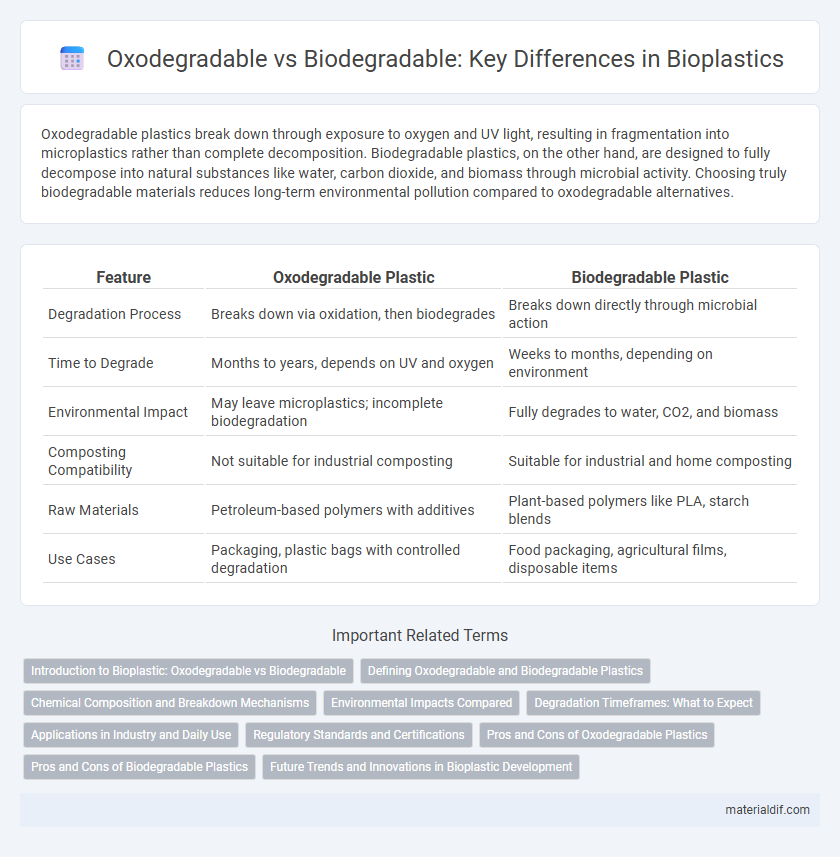Oxodegradable plastics break down through exposure to oxygen and UV light, resulting in fragmentation into microplastics rather than complete decomposition. Biodegradable plastics, on the other hand, are designed to fully decompose into natural substances like water, carbon dioxide, and biomass through microbial activity. Choosing truly biodegradable materials reduces long-term environmental pollution compared to oxodegradable alternatives.
Table of Comparison
| Feature | Oxodegradable Plastic | Biodegradable Plastic |
|---|---|---|
| Degradation Process | Breaks down via oxidation, then biodegrades | Breaks down directly through microbial action |
| Time to Degrade | Months to years, depends on UV and oxygen | Weeks to months, depending on environment |
| Environmental Impact | May leave microplastics; incomplete biodegradation | Fully degrades to water, CO2, and biomass |
| Composting Compatibility | Not suitable for industrial composting | Suitable for industrial and home composting |
| Raw Materials | Petroleum-based polymers with additives | Plant-based polymers like PLA, starch blends |
| Use Cases | Packaging, plastic bags with controlled degradation | Food packaging, agricultural films, disposable items |
Introduction to Bioplastic: Oxodegradable vs Biodegradable
Oxodegradable plastics degrade through oxidative reactions triggered by heat or UV light, breaking down into smaller fragments but not fully decomposing into natural elements, often leading to microplastic pollution. Biodegradable plastics are designed to be broken down by microorganisms into water, carbon dioxide, and biomass within a specific timeframe, reducing environmental impact. Understanding the distinction between oxodegradable and biodegradable bioplastics is crucial for selecting sustainable materials that align with circular economy goals and waste management infrastructure.
Defining Oxodegradable and Biodegradable Plastics
Oxodegradable plastics contain additives that accelerate fragmentation when exposed to oxygen, resulting in microplastics rather than complete decomposition. Biodegradable plastics are designed to be broken down entirely by microorganisms into natural substances like water, carbon dioxide, and biomass within a specific time frame. Understanding the distinct degradation mechanisms of oxodegradable and biodegradable plastics is crucial for assessing their environmental impact and suitability for sustainable packaging solutions.
Chemical Composition and Breakdown Mechanisms
Oxodegradable plastics contain additives such as metal salts that catalyze oxidation, leading to fragmentation under UV light and heat, but their chemical breakdown into non-toxic molecules is incomplete and slow. Biodegradable plastics are composed of polymers like polylactic acid (PLA) or polyhydroxyalkanoates (PHA) that microorganisms enzymatically decompose into water, carbon dioxide, and biomass under composting conditions. The key distinction lies in oxodegradable plastics' abiotic oxidative cleavage followed by limited biodegradation, whereas biodegradable plastics undergo direct microbial assimilation and mineralization.
Environmental Impacts Compared
Oxodegradable plastics fragment into microplastics through oxidation but do not fully biodegrade, posing long-term environmental risks by contributing to microplastic pollution. Biodegradable plastics, derived from natural polymers, break down completely under microbial action, reducing soil and water contamination while supporting ecosystem health. Regulatory trends favor biodegradable materials due to their lower ecological footprint and enhanced compatibility with composting infrastructure.
Degradation Timeframes: What to Expect
Oxodegradable plastics typically degrade within 6 to 24 months through oxidative processes but often leave microplastic residues, whereas biodegradable plastics break down completely into natural elements within 3 to 12 months under industrial composting conditions. Factors influencing degradation timeframes include temperature, humidity, and microbial activity, with biodegradable materials performing best in controlled composting environments. Understanding these differences is crucial for selecting sustainable packaging solutions aligned with environmental goals.
Applications in Industry and Daily Use
Oxodegradable plastics are primarily used in packaging and agricultural films due to their ability to break down under UV light and oxygen exposure, but they may leave microplastic residues that pose environmental concerns. Biodegradable plastics find extensive applications in food packaging, disposable cutlery, and medical supplies, where full decomposition by microorganisms in composting environments ensures minimal ecological impact. Industries increasingly prefer biodegradable materials for sustainable solutions, while oxodegradable options remain limited by regulatory restrictions and potential toxicity of residues.
Regulatory Standards and Certifications
Oxodegradable plastics degrade through oxidation triggered by environmental factors but often fail to meet stringent regulatory standards for complete biodegradability, leading to limited certifications such as ASTM D6954. In contrast, biodegradable plastics comply with recognized international standards like ISO 17088 and EN 13432, ensuring full decomposition into non-toxic residues under specific conditions, which supports broader certification acceptance. Regulatory agencies prioritize certifications that verify environmental safety and degradation timelines, influencing market adoption and policy support for biodegradable over oxodegradable materials.
Pros and Cons of Oxodegradable Plastics
Oxodegradable plastics degrade through oxidation, breaking down into smaller fragments under UV light and oxygen but do not fully biodegrade into natural elements, posing environmental concerns due to microplastic residue. These plastics offer cost-effective disposal and improved degradation speed in open environments compared to traditional plastics, yet they lack certification as compostable or fully biodegradable, limiting their sustainability profile. Their reliance on environmental conditions for degradation and potential contribution to microplastic pollution present significant drawbacks compared to biodegradable bioplastics designed for complete microbial decomposition.
Pros and Cons of Biodegradable Plastics
Biodegradable plastics break down naturally through microbial activity, reducing long-term pollution and landfill accumulation. They promote sustainability by minimizing reliance on fossil fuels and supporting composting systems, yet often require specific environmental conditions to decompose effectively, limiting their convenience in typical waste management. Challenges include potential contamination of recycling streams and variable degradation rates depending on material composition and disposal environment.
Future Trends and Innovations in Bioplastic Development
Future trends in bioplastic development emphasize enhancing the environmental compatibility of oxodegradable and biodegradable materials through advanced formulations that accelerate degradation while minimizing microplastic formation. Innovations focus on integrating bio-based additives and enzymatic catalysts to improve biodegradability in diverse environmental conditions, promoting a circular economy. Emerging research prioritizes scaling sustainable production methods, increasing the use of renewable feedstocks, and optimizing end-of-life processes to reduce plastic pollution effectively.
Oxodegradable vs Biodegradable Infographic

 materialdif.com
materialdif.com